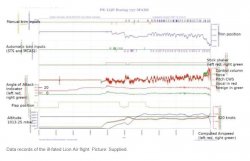Presentation to Indonesian Parliament (
The Australian, probably pay-walled)
From the Australian:
A presentation to the Indonesian parliament on the Lion Air crash has revealed the pilot basically fought with the aeroplane to the end of the flight.
Appearing before the House of Representatives in Jakarta, National Transportation Safety Committee aviation head Nurcahyo Utomo explained the data retrieved from the flight recorder.
He said the graphs showed that when the Boeing 737 Max began to move, the captain and co-pilot received different airspeed readings.
The parliament heard the aircraft continued to go up and down to a height of 5000 feet, until a “stall condition” was triggered as a result of misleading data coming from one of the angle of attack sensors.
“When it is 5000 feet high, here it is noted that the purple line is automatic trim down, or what is called MCAS. This is a tool to lower the nose of the plane because the plane will stall,” Mr Nurcahyo explained.

“This movement is opposed by the pilot with the blue parameter. So after the trim down, the pilot commanded electric trim continued to fight until the end of the flight.”
He explained that the MCAS trimmed at a faster rate than the pilot commanded trim, making it increasingly difficult to control the aeroplane.
“It was noted at the end of the flight, the automatic trim increased, but the trim of the pilot was shorter,” said Mr Nurcahyo.
“Finally, the number of trims gets smaller and the load on the steering wheel becomes heavy, then the plane drops.”
Analysis of the flight data recorder showed the 737 Max had no engine problems.
Mr Nurcahyo confirmed that the aircraft experienced the “same obstacles” on the previous flight from Denpasar to Jakarta but said in that instance the pilot was able to control the plane.
It is believed the pilots on flight JT610 had prepared for an unreliable airspeed event prior to take-off, and believed that was the issue when they requested to return to Jakarta.
The subsequent high speed crash into the Java Sea on October 29, claimed the lives of all 189 people on board.
Although the flight data recorder has been retrieved and analysed, investigators are still looking for the coughpit voice recorder which will shed more light on the tragedy.















